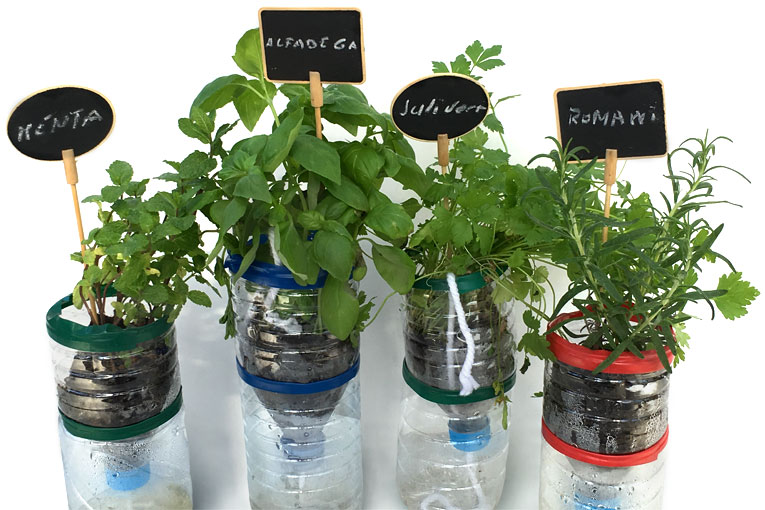
We live in a time, culture and civilisation in which recycling is an educational value for our society, a value added for our everyday habits that should be boosted by all educational sectors as a guideline reference for the future.
The word recycling means giving a new life, either with a new form or a new use. As always in our projects, this time we propose to everyone another way of giving used plastic bottles a new life and making the most of them building a kind of culinary garden for our meals. Thus, we will enjoy gardening and cuisine at the same time.
Below we present some data to learn about the importance of recycling for city sustainability: What benefits does recycling bring? We have observed the data from Ecoembes1 and, in the case of plastic and packaging like cans or bricks, the numbers of 2014 are very suggestive and surprising. According to this report, there are a total of 357,486 yellow containers around the country, which amounts to a container for every 130 inhabitants. The material goes to 95 materials recovery facilities, where 61.4% of the plastic household packaging in Spain are recycled. This number is very high, if we bear in mind that the minimum target set by the European executive committee is 22.5% of the total of plastic packaging, cans and bricks. This report also states that 12.3kg – per inhabitant – of plastic and metallic packaging and bricks are recycled every year.
A value added to this way of doing things is the impact that it has for the quality and sustainability of our cities. Firstly, it leads to a reduction in CO2 emissions, a total of 1.2 million tonnes that will no be given out to the atmosphere in the materials manufacturing processes. It is equivalent to removing 25% of the registered cars in Madrid from circulation. Just to name some more comparisons, this recycling rate represents an energy saving of 3 million MWh, as much energy as 31% of the smartphones in Spain consume. In addition, 24.5 million m3 of water are saved, a quantity that matches the yearly consumption of a city with 438,000 people. As you can see, recycling is a small gesture with a huge repercussion for the planet.
Activity: Aromatic garden in recycled bottle
Materials
—1.5 l plastic bottles
—A cutter or knife, scissors and a bradawl
—Tape of different colours
—A yarn of thick cotton or wool
—Soil
—Aromatic plants
Procedure

Then we make triangle-shaped holes at the upper part. It is easy to do if we heat the tip of the bradawl, taking care not to burn yourself, or with a pair of scissors. These holes will keep water from collecting there when we water the plants.
We smooth the cutting edges with scissors and then we cover them with the tape. In this way we give colour to the pots and, at the same time, we protect the edge so we do not harm ourselves. We choose as many colours as the number of plants we have, so we will be able to identify them.
We also drill a hole on the tap, as wide as the cotton yarn. This yarn will be used for watering plants, since water will go up from the tank – the bottom of the bottle – to the soil container. We put the yarn so that it touches the bottom of the bottle, and then it should go through the soil zone to the top, to make sure that water reaches the upper part. Once we have the cotton yarn in its place, we begin to fill the container with earth and put the plant in it.
It is important to use a good substrate – porous and with optimal components – since that fact will avoid most of the problems that the plants could suffer. We recommend buying a quality substrate or producing your own. We can make it by mixing different components, considering that potted plants need more nutrients and better substrates than those on the ground. In every mixture we should find an element that brings porosity and structure, and another one with the necessary nutrients. We can recommend a mixture of 60% coconut fibre and 40% worn humus. However, this is only one of many options.
Finally we put the chosen aromatic plants – those we like the most and use the most to cook. We should acquire a taste for them, since they are good for our health and they help us reduce the amount of salt we add to our meals. It is easy, at any time in the year, to get an aromatic plant for our aromatic garden.
Watch the video of this activity on Mètode TV.





